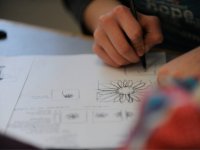4 Strategies to Help ELLs in the Mainstream Classroom
Help ELLs join the mainstream by having them read a book every day, planning multi-modal lessons, shortening your lessons, and making sure that they write.
Your content has been saved!
Go to My Saved Content.It is possible to help a beginning English-language learner (ELL) improve so much in a matter of months that he or she can pass the sixth through eighth grade state standardized tests. This student can go from five to 50 percent on a school curriculum test. It's happening in my middle school classroom, and it can happen in your classrooms, too. With the right support and differentiation, ELLs will be successful in your general education or language arts classroom.
As you read the following, keep in mind that these ELL strategies are good for engaging all students. That's because they're interactive and focus on the four domains of language -- reading, writing, speaking, and listening -- which all students need support in developing. Often with general education students, reading and writing get the most attention, while speaking and listening development are neglected.
1. Students should read a book of choice every day.
Research shows that reading daily improves a student's fluency, comprehension, vocabulary, analytical skills, and memory. Work with your librarian to give your students access to books at all levels. Encourage them to read books from different genres at their level. If you have students still struggling with English, computer programs such as i-Ready, Kurzweil, or Starfall can give them a foundation. Transition them to children's books or graphic novels after a month or two.
Once the students are finished reading, creatively tie their silent reading time into your curriculum and lessons. If you're introducing or reviewing "conflict," ask the students to explain and define the conflicts in their books. Relate back to their books with any of the other reading concepts, too. If you're working on a writing conventions mini lesson, have the students refer back to their books to see how their author uses these conventions. The students need to know that their silent reading relates to the big picture.
2. Your lessons should be multimodal.
Teachers need to present material in various ways to reach all types of learners. You can easily prepare ahead of time by adding visuals that will help the students gain access to the content.
Before each lesson, pull up different internet tabs (or apps like the Oxford Picture Dictionary) that include images, videos, and other multimedia to help ELLs understand parts of the vocabulary lesson. A folktale lesson about the "The Crane Maiden," for example, should include vocabulary like crane, marsh, loom, and quilt. These vocabulary words will add to a general idea of what the story is about. Pull up pictures on Google Images and click through them during the lesson as you explain and pre-teach the vocabulary. The story also talks about a maiden using a loom. Along with the images, present a YouTube video of someone using a loom to make a beautiful quilt. These activities will bring about authentic learning and draw from background knowledge.
3. Shorten your lecture.
When students are engaged daily in structured conversations, they are learning. The teacher should facilitate that learning. Structure your class so that you're giving five- to seven-minute lectures and then allowing the students to discuss the subject with guided questions and prompts that use academic vocabulary.
As the rest of the class reads from L. Frank Baum's The Wizard of Oz, ELLs might read from a children's version and watch a few video clips from the classic MGM film that go with the chapter. Show them the tornado scene, the Munchkin scene, and the Yellow Brick Road introduction, giving them visuals to help them during the structured conversations. After reading, the groups will have meaningful, authentic conversations about what they just read. While the teacher facilitates the process, instead of standing in front explaining, the beginners can start piecing together vocabulary that they see and hear.
4. The students must be writing.
The only way students are going to improve at writing ideas and conventions is to actually write. They should practice writing what they are passionate about -- and that doesn't come from worksheets and drills. After writing sentences and essays, they should learn how to edit and revise their own errors. We should not be correcting their essays for them.
Allow the students to choose topics of their choice. Give them a guide to follow, but don't confine them to certain topics, number of paragraphs, or sentences. They should decide what they want to write about and how they want to write. As they finish their first draft, guide them through ratiocination techniques. In terms of language, this means focusing on word usage, "to be" verbs, run-on sentences, repeated words, and more, rather than the content. Don't correct students' errors for them. This helps them recognize their own errors now and for the future. ELLs can use these techniques, too. When you use mentor texts to explain writing conventions in mini lessons, students will learn how to write as they see these models and look for their own errors. They will jump from beginners to intermediate or advanced writers in a matter of months using these skills.
With these four strategies, I guarantee that you will see incredible improvements in your middle school students. My students were engaged in the lessons and learned new vocabulary words and content each day. I didn't have discipline problems with them because they weren't bored or confused. They improved on curriculum and district tests at an average rate of 15-30 percent when we followed these four strategies.
ELLs and other students can all benefit from these strategies in general education classrooms. Let’s not shelter them from this authentic and enriching learning environment.
